A lovely breed historically bred for coursing and hunting, which gained prominence from Greyhound racing.
A greyhound is a gazehound whose prominent sense is strong sight.
Its slender legs and sleek body can reach speeds out taking other breeds.
Greyhound is a perfect breed to find a place into your affectionate little family as it has a calm but playfully energetic nature.
Table of Contents
Quick Facts

Avg. Weight: Male: 65-70 pounds (male), 60-65 pounds (female)
Avg. Height: Male: 28-30 inches (male), 27-28 inches (female)
Life Expectancy: 10 -14 years
Dog Group: Gazehound, sporting dog
Colors: Brindle, Black, White, Fawn and around 25 more variations
Dog Rank: 145/193 (United States of America)
At a Glance
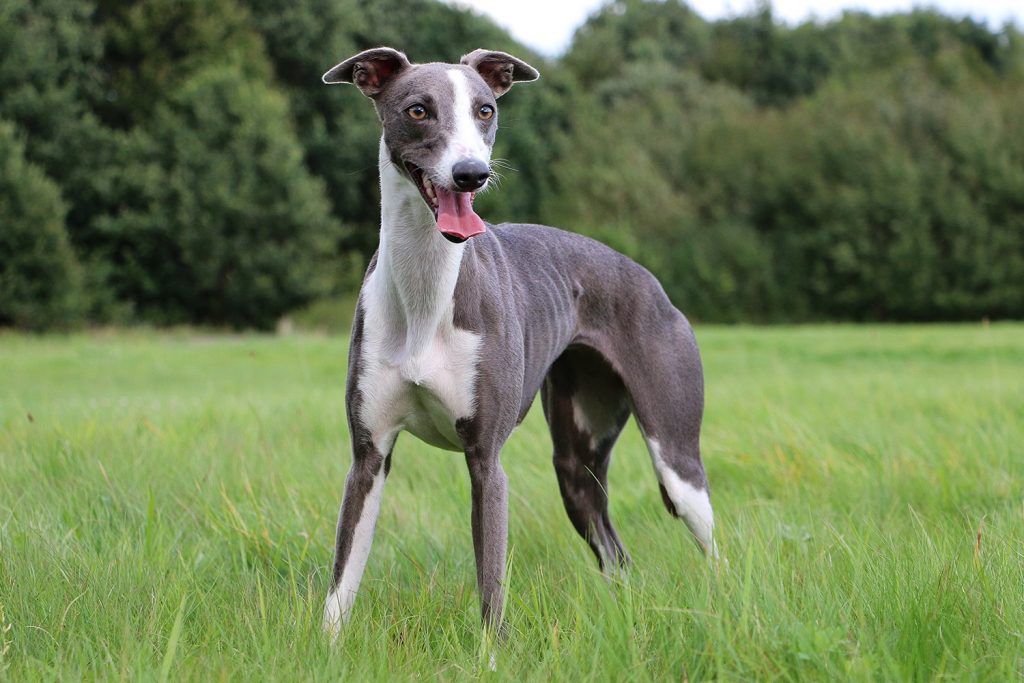
- Size (4/5)
Greyhound is a little taller than a golden retriever but has a slender body structure.
Though considered large, these dogs are unobtrusive.
On an average, a greyhound puppy weighs from 4 to 6 lbs depending on the fact if it’s an Italian greyhound puppy or a greyhound.
- Affection Level (5/5)
Greyhound finds it easy to bond with humans and though some dog breeds tend to pick a favorite person in the family, the greyhound showers its love to all mostly equally.
- Apartment-Friendly (4/5)
A greyhound is listed among the large dogs of the world but still, its calm nature and gentle behavior are unobtrusive to the apartment environment.
Greyhound is less turbulent than its counterparts like the whippet or the Italian greyhound.
- Cold Weather Tolerability (1/5)
Breeds like the greyhound are vulnerable to cold as they have single thin coats and low body fat.
A sweater or jacket might do the job to take your hound out for a walk on a cold day.
Suitable winter temperature for a greyhound is around above 10oC.
- Hot Weather Tolerability (5/5)
The greyhound is strictly an indoor dog with little tolerance to extreme climate which includes heat.
Though heat serves better to the hound than cold, it is still the owner’s responsibility to keep the dog in a well-shaded area and not take it out in the heat for long walks.
Suitable summer temperature for a greyhound is up to 30oC.
- Barking Tendencies (2/5)
The hound is a little of a chatterbox when it comes to keeping quiet.
It is a kind which expresses many emotions by barking or howling and so if you are looking for a greyhound, you better be fond of its talkativeness.
This tendency can be controlled if trained since the very puppyhood but as it is in its nature, it cannot be completely suppressed.
- Cat-Friendly (1/5)
A greyhound is an instinctive hunter and sees a cat as prey.
Though you might hear that if a hound is made to grow up with cats, it develops friendliness, you should refrain from having this breed in your house with a cat.
A hound can be trained to behave well with cats but a test showed that every time a cat ran, the hound mostly couldn’t stay stagnant.
- Dog-Friendly (4/5)
In a world where the pets are becoming an every family affair, where people are not satisfied by just one dog alone, the question arises “Do Greyhounds get along with other dog breeds”.
They are well in socializing with other dogs due to their calm and gentle nature but when it comes to the small dog breeds or small animals, a hound sees them as prey and so they have to be trained to behave and regularly made to socialize with all pets since the puppyhood.
- Exercise Needs (4/5)
A greyhound is an indoor dog whom you will mostly find laid down on the floor, relaxing its way through the day.
A run in the yard or one hour walk per day is sufficient to maintain hounds health and physique.
This breed uses its energy in short bursts and is built for speed and stamina, so playing Frisbee or fetch the ball for half an hour per day would also suffice in keeping its health maintained.
- Grooming Needs (5/5)
The good thing about these dogs is that they need relatively less care for keeping tidy.
They are rough and tough and so can play in almost any area without them catching any infection.
Also as they mostly lay indoors, it takes minimal effort and time to groom them.
Hounds don’t fall under the list of dogs that drool or have a naturally strong doggy odor.
Also, greyhounds have only one coat of hair making them mostly shed free.
- Playfulness (4/5)
Though this breed is gentle and calm, it loves playing.
Hounds are not very fond of playing with toys but when it comes to games that challenge its instincts, it wants to do well.
Games like fetch, Frisbee can make their day.
It also gets along with kids and other dogs quite well and can use them as a medium to fulfill its playfulness.
- Trainability (4/5)
Though a lot of breeds demand patience in learning etiquettes and responding to their trainers, the greyhound is relatively one of the easiest breeds to train and is a fast grasper.
It can be molded to the ways of your household in a very short time, less repetition of action and without much of a hassle.
Point to be noted – always use positive reinforcement with this breed and be calm as the dog can also develop a fear against its trainer.
- Intelligence (5/5)
A hound is an intelligent breed dependent more on its eyes than its nose.
It can make a good herding dog or can be used in hunting which is the domain where its intelligence lies.
It needs fewer repetitions to get familiar with commands and also learns the whereabouts of its home very well.
- Mouthiness (4/5)
Along with being a chatterbox, this breed is also mouthy in nature.
You can expect a lot of licking and painless biting.
It loves to keep its mouth active and so it has to be trained to chew on the chew toy rather than people.
Mouthy dogs love to play fetch and chew on the toys filled with a treat.
- Price Group (3/5)
To own this breed can be a costly affair as the pricing of a purebred hound ranges from $2500 – $15000.
At some places, it can also cost from $1000 – $4000 depending on the popularity or rarity of the breed in an area.
Greyhounds have been around since the Egyptian era. This breed has also been mentioned in the bible 14 times.
FACT-ILLICIOUS
About Greyhounds
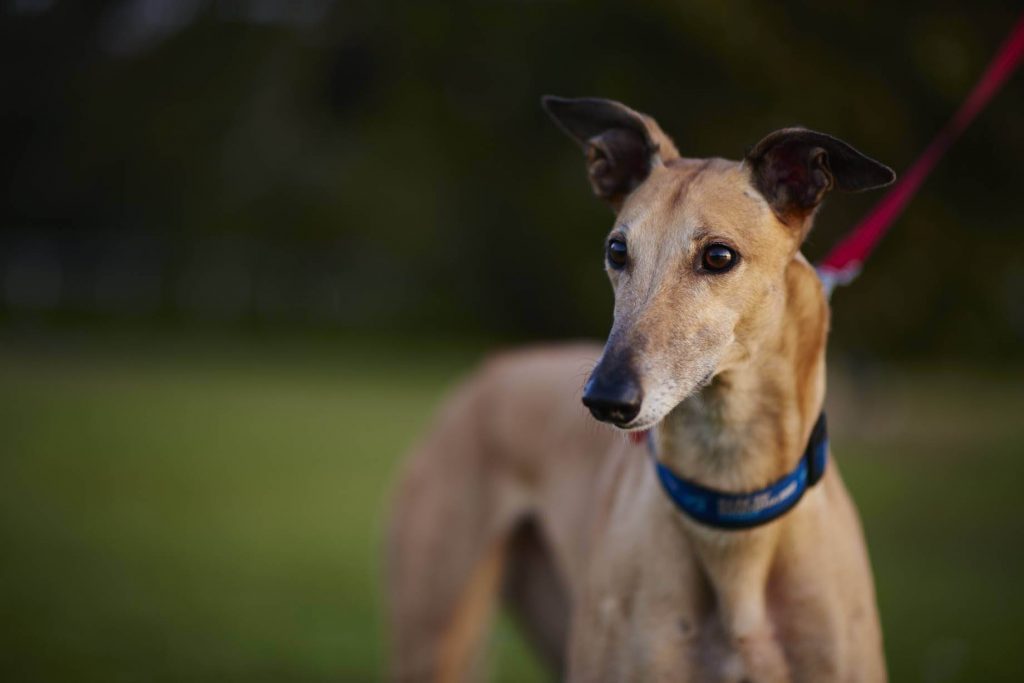
Greyhound is one of the most comfortable breeds to live with, its calm and gentle nature makes it family friendly.
They form great pets who are loyal and devout to their household.
A hound is a great companion of humans and has a wonderful temperament which makes it easy to mingle even with kids and neighbors.
Greyhound comes in many shades of coats and color ranging up to approximately 30.
From black to white, from red to a dazzling fawn, whichever appeals your eyes.
It has to be kept regularly in a socializing environment or it can grow up to be aloof in its adulthood that is from 18 months to 5 years of age.
If trained well from puppyhood it can grow up to be very playful and lively.
Where Greyhounds Came From?
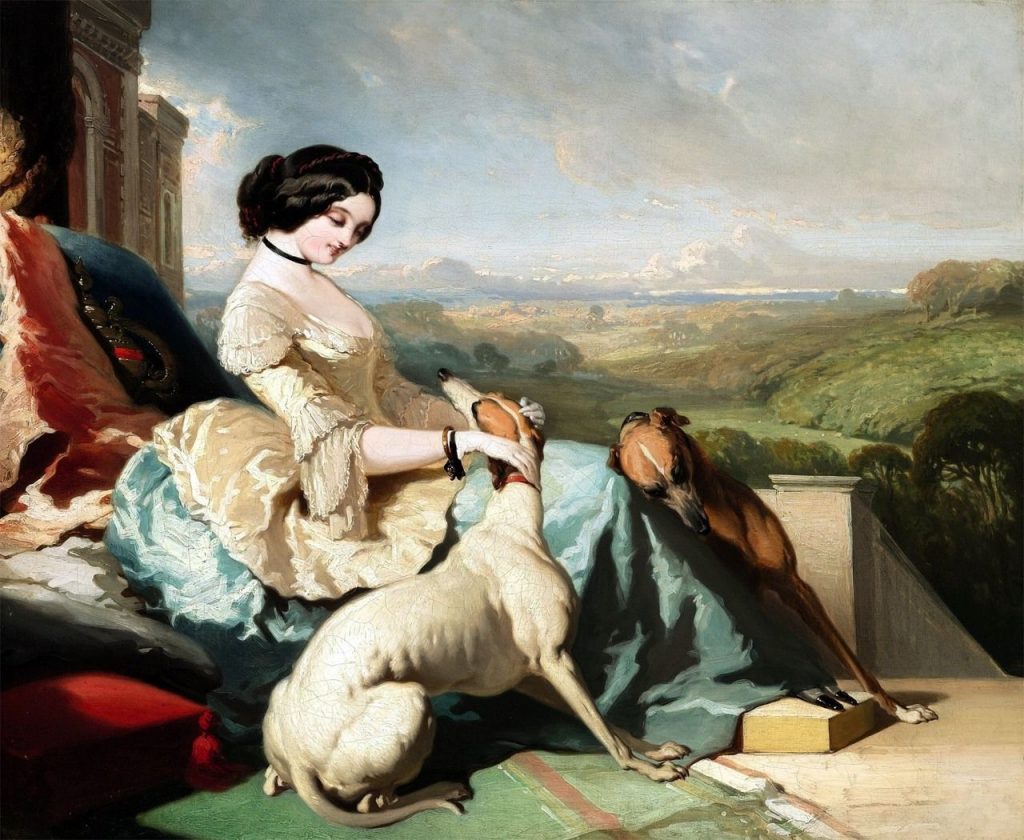
Greyhounds are said to be the oldest purebred canines which can be dated back to ancient Egyptian times.
The hounds got recognized as a breed originating from England in the early 1800s.
In our recent history greyhounds were used for coursing, a really cruel sport but things changed after the breed was introduced to greyhound racing, a race between the hounds to catch the mechanical lure.
Greyhounds are among the breeds used for herding as they are agile and intelligent.
After years of hunting, racing and herding the breed finally found its place into family households and got the recognition of one of the best breeds to live with.
Size
The hound is usually bigger than a medium-sized dog unless it is the whippet or the Italian greyhound who are its smaller counterparts.
The growth of a greyhound like any other dog breed depends on its genes, food, and physical activity.
Though it can grow large, it is one among the least disturbing breeds in a household as it likes to spend its time lying and relaxing.
Trainability
Being closely related to the herder dog, it is very intelligent and a quick grasper.
It can pick on commands quickly especially when treated on obeying them.
Hounds are intelligent but what they need is a positive way of training and commanding.
Being a gentle kind, the breed is quick to develop fear against the trainer if scolded or beaten for making it obey.
Hound should be given the basic training of hygiene and socializing since its early days but if you want it to be trained for something specific then have the patience to wait till it’s over 3 months old.
Yes, the breed is mouthy and so try to never run out of chew toys.
Grooming
Greyhounds are ‘wear and tear’ breed. A minimal amount of effort is needed to keep this breed tidy.
Bathing is something that the hounds need to go through once in 8 to 10 weeks or when dirty out of a game or playground.
Bathing often can strip the essential oils of their skin and make the coat dry.
Teeth of a hound stay in great shape if brushed at least thrice a week with soft bristles.
But still, it is recommended to brush their teeth daily to prevent plaque and tartar.
Lightly comb your hound for 5 minutes every day.
Most wouldn’t shed but if they do, it wouldn’t be in bothersome amounts.
Feeding
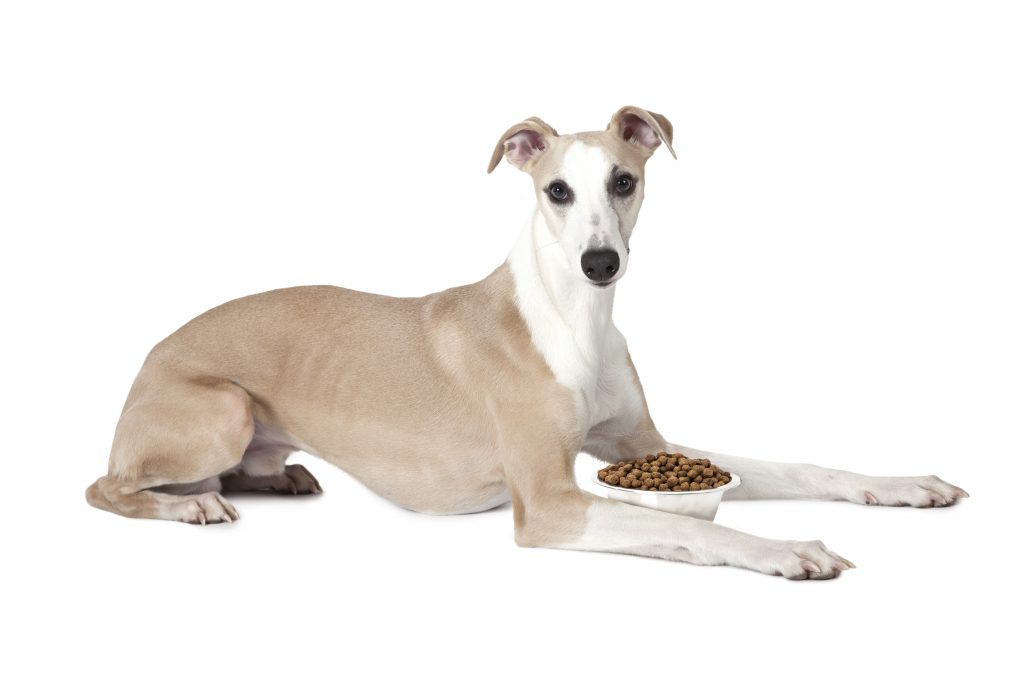
A meat-based diet would be good for your hound but yes you can also feed your greyhound a premium commercial dog food.
Diced or minced meat of chicken, turkey or beef will do well.
Racing greyhound diet should mainly include raw meat.
The greyhounds that compete in the race are fed raw meat on the track.
A hound should be fed more than 4 cups of premium quality dog food daily which is a little more than what an average dog requires, especially in case of large hounds and this shall be discussed with a vet.
The amount of water needed to keep any dog breed healthy is 1- 1 and a half ounces per pound of body weight.
Make sure to keep the food and the water cup on a raised platform or holder as the hound is tall and it can be awkward for it to eat from a cup placed on the ground.
Suggested: Senior Dog Food
| What Should Be Fed | What Should Not Be Fed |
| Potatoes | Onion |
| Broccoli | Grapes |
| Beef | Caffeine |
| Chicken | Chocolates |
| Turkey | Salty food |
| Eggs | Alcohol |
| Rice | Avocado |
To be surer about what you can feed your dog and what can be dangerous for it, go check out 48 Toxic Foods For Dogs that you might be feeding your pet unknowingly.
Common Diseases
- Bone Cancer:
The most commonly seen disease in a greyhound is cancer, especially bone cancer.
It claims the lives of many hounds.
- Bloated Stomach:
Feeling bloated after a heavy meal might be discomforting to humans but it can be fatal to dogs, over that it is common among the Greyhounds to go through the bloat or gastric torsion.
In fact, it is so deceiving that at the minute you might find your dog completely fine and some hours later it might turn out to be dead.
- Pannus:
Pannus is a common eye disease found in the greyhound.
It starts at the age of around 2-5 years and if left untreated can make the dog completely lose its sight.
Though there is no cure, this disease once caught, its progression can only be slowed.
- Heart Murmurs:
Due to the fact that these dogs have a relatively big sized heart and mostly have high blood pressures, they are prone to develop heart murmurs.
It is common in greyhounds and is something of minor concern, but still, heart murmurs should be kept monitored so that they don’t turn into something worse.
- Other Common Diseases:
Tick-Borne Diseases, Protozoal Infections, Lyme Disease, Worms, Dental Disease, Osteoarthritis, And Intervertebral Disk Disease are some other diseases common to not only greyhounds.
Vaccination and Care
For starters, look into your dog’s health history and in case of a pup, look into the health history of its parents for any genetic disease or hereditary condition.
Make sure you get your puppy from a reputed breeder.
Look into its hygiene and cleanliness every day, do your best to keep your dog tidy and this would prevent it from catching a lot of infections.
Take your dog out for a walk or to play and feed it with nutritional food.
Refrain from overfeeding your dog as that would help maintain your dog’s shape and prevent obesity.
This would help in extending your dog’s lifetime.
Greyhound, like any other dogs, should receive a vaccine against rabies, parvovirus, distemper, hepatitis and the two causes of canine cough.
For getting your hound vaccinated, visit a vet who will help set a schedule for your dog to be effectively vaccinated.
Suggested: Guide To Dog Vaccination
Monthly Expense Estimation
A greyhound puppy from brought home from a reputed breeder might cost heftily, which is around $1000- $4000 and at some places this range can shoot up to $15000 depending on the rarity of the breed.
Although a costly breed, if you adopt a greyhound, its cost can range around as low as $300.
As the hound is kind of a low maintenance dog, it only requires $70- $90 per month to keep it healthy and tidy.
Greyhounds are the fastest dog breed who can touch speeds up to 45 mph. They have a nickname – ’40 mph couch potato’ as they are fast on the track and lazy indoors.
FACT-ILICIOUS
Behavior
Children
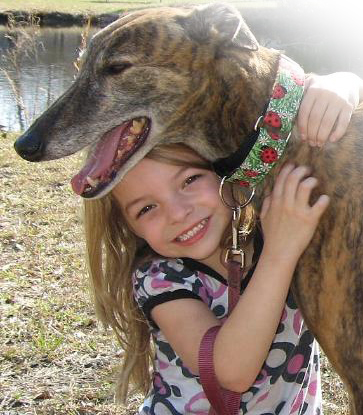
The breed is quick in forming a bond with humans and this helps children to never feel threatened but rather loved by this breed.
It is one of the best breeds of dog to keep as a family pet and its calm and gentle nature is always welcoming to kids and neighbors.
A day at the park with a Frisbee can make the day of both your children and your hound.
Socializing helps in shaping any dog’s behavior and so to prevent your dog from growing aloof, make it play with the kids and neighbors a lot.
Dogs
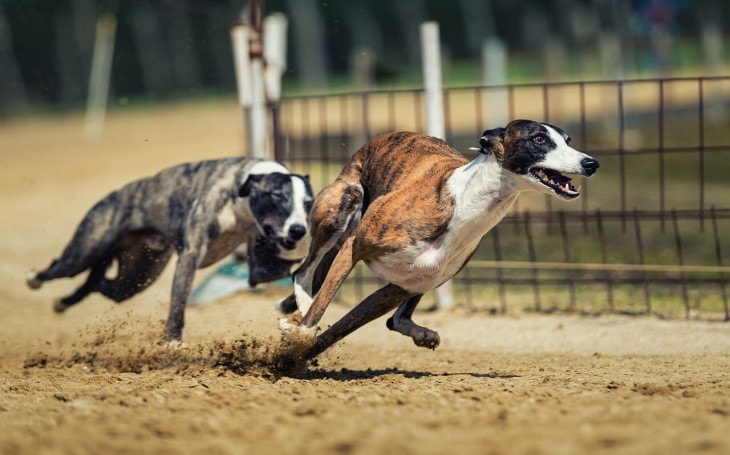
Yes, it is a very well behaved breed when it comes to interacting with other dogs unless aloof or kept away in seclusion since puppyhood.
The only bad point about a hound is that it is a hunter by nature and it sees anything smaller to it as prey and so toy dogs should be kept away from this breed.
Training can help in building their socializing skills with other dogs and make their behavior more welcoming.
Cats
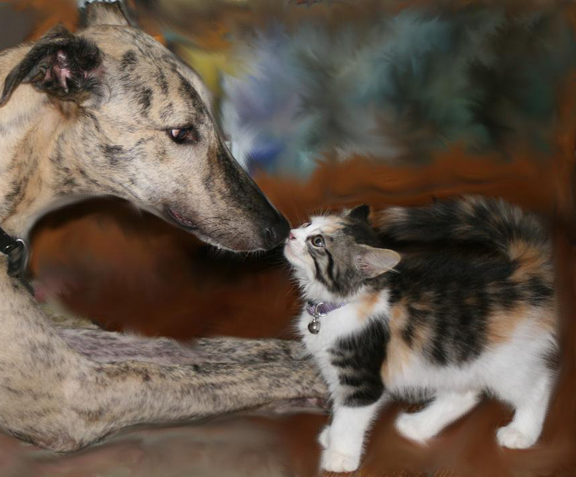
Greyhounds are not at all cooperative when it comes to living with a cat unless they have grown up with one, but even so, there have been cases where the hound couldn’t resist but see a running house cat as prey.
They can be trained to not do so but as it is their natural instinct, it can only be suppressed and not erased.
Cat owners should refrain from taking this breed home as pets.
Overview
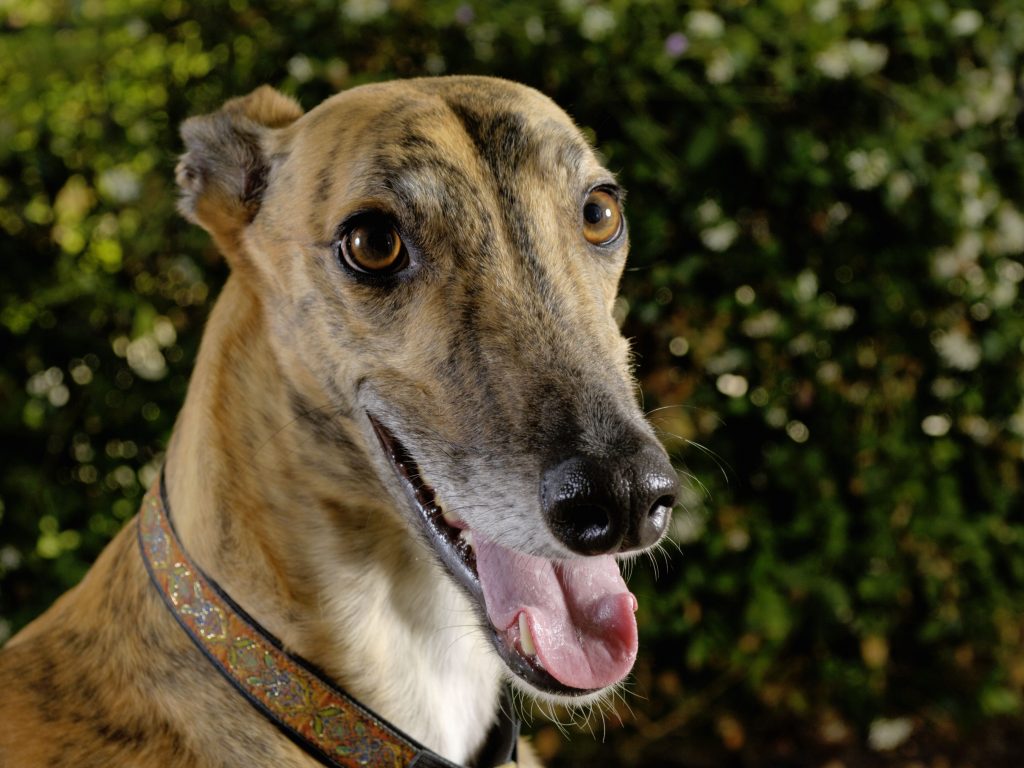
If you love a dog that is calm at home but energetic and playful outside then this is the perfect dog for you.
It is a chatterbox and loves nibbling on something and so giving it a chew toy would satisfy its mouthy habits.
It is a large but slender breed that is fond of relaxing, so its size wouldn’t interrupt your daily household chores and also its apartment friendly nature wouldn’t require you to have an attached yard to satisfy its needs.
It is a rough and tough dog with minimal requirements for grooming.
Just an hour of playing or walking outside is enough to keep the hound in shape.
But it requires a little more feeding than other breeds.
It socializes well with dogs, children, and neighbors making it a perfect family dog.
Greyhound Racing Facts
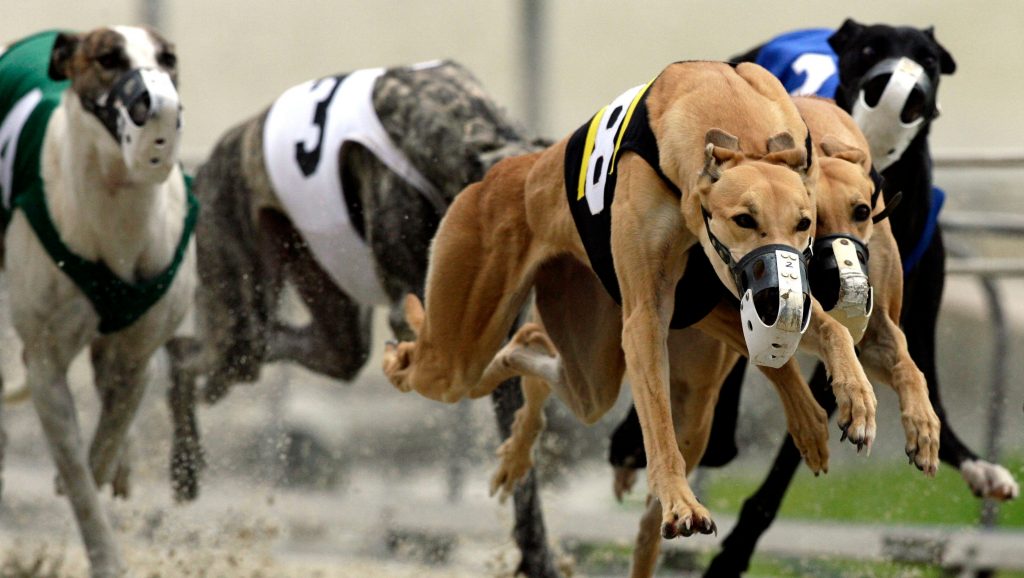
Many greyhounds bred and raised for racing are drugged so as to win the race
They are kept mostly in cages or kennels separated from each other for 23 hours.
There’s merely any way of socializing for greyhounds raised for racing.
Many greyhounds get seriously injured in the race and in extreme cases die from the injuries taken.
When a greyhound is retired from racing it faces an uncertain future.
Most of them are killed and only the lucky ones find a home through adoption.
So please do consider to adopt a greyhound as a pet and give it the affection it deserves.
What are your views on greyhound racing?
Should people be pro greyhound racing or against it and why?
Please put a comment below.
Finding yourself confused about getting a greyhound?
Go check out the new dog checklist which will help you decide which breed will suit your household the best.













[…] Greyhound may surprise you as an apartment friendly breed, as they are well known for their dynamic and agile characteristic. […]
[…] Greyhounds are just a smaller version of Greyhounds. They were originally bred to hunt and still have their hunting instincts to this […]
[…] lethal and can cause malignant hyperthermia and hops toxicity. Any breed can be affected by it but Greyhounds, Labrador Retrievers, Saint Bernard, Border Collie, and Dobermans are more susceptible to […]
[…] Greyhound […]